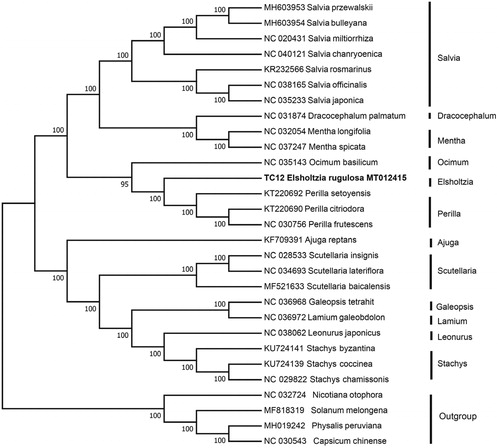Abstract
Elsholtzia rugulosa is a medicinal plant commonly used in southwest of China. In this study, we sequenced the complete chloroplast (cp) genome sequence of E. rugulosa to investigate its phylogenetic relationship in the family Labiatae. The chloroplast genome of E. rugulosa was 151,952 bp in length with 37.9% overall GC content, including a large single copy (LSC) region of 83,056 bp, a small single copy (SSC) region of 17,526 bp, and a pair of inverted repeats (IRs) of 25,685 bp. The cp genome contained 113 genes, including 80 protein-coding genes, 29 tRNA genes, and 4 rRNA genes. The phylogenetic analysis indicated Elsholtzia was closely related to Perilla.
Elsholtzia is a genus of the Labiatae family, which includes 40 species in the world. Most of them are widespread in Europe, Japan, Korea, North America. There are 33 species in China (Li and Ian Citation1994). Plants of this genus have been widely used in traditional Chinese medicine for thousands of years (Minru and Yi Citation2016). Among these species, E. rugulosa is widely distributed in southwest China which has been used in ethnic medicine in the treatment of dysentery, dyspepsia, Gastritis, nephritis, otitis media, hemorrhage, and ascariasis (Minru and Yi Citation2016). However, up to now for such medicinal plants, many studies have mainly focused on essential oil composition (Zhang et al. Citation2016), phenolic ingredients (Zhang et al. Citation2016). the genome information of E. rugulosa is too little published in GenBank so that insufficient comprehensive genomic resource is conducted for it. At present, we report the chloroplast genome sequence of E. rugulosa and find its internal relationships within the family Labiatae, which can provide basic data for further research of genus Labiatae species useful genome resource in China.
Fresh and clean leave materials of E. rugulosa were collected from Lijiang city, Yunnan, China (N26°55′33.88″/E100°14′09.02″), and the plant materials and a voucher specimen (TC12) were deposited at Tourism and Culture College of Yunnan University (Lijiang). Total genomic DNA was extracted using the improved CTAB method (Doyle Citation1987; Yang et al. Citation2014), and sequenced with Illumina Hiseq 2500 (Novogene, Tianjin, China) platform with pair-end (2 × 300 bp) library. About 8.39 Gb of raw reads with 10,500,370 paired-end reads were obtained from high-throughput sequencing. The raw data was filtered using Trimmomatic v.0.32 with default settings (Bolger et al. Citation2014). Then paired-end reads of clean data were assembled into circular contigs using GetOrganelle.py (Jin et al. Citation2018) with Scutellaria baicalensis (NC_027262) as reference. Finally, the cpDNA was annotated by the Dual Organellar Genome Annotator (DOGMA; http://dogma.ccbb.utexas.edu/) (Wyman et al. Citation2004) and tRNAscan-SE (Lowe and Chan Citation2016) with manual adjustment using Geneious v. 7.1.3 (Kearse et al. Citation2012).
The circular genome map was generated with OGDRAW v.1.3.1 (Greiner et al. Citation2019). Then, the annotated chloroplast genome was submitted to the GenBank under the accession number MT012415. The total length of the chloroplast genome was 151,952 bp, with 37.9% overall GC content. With typical quadripartite structure, a pair of inverted repeats (IRs) of 25,685 bp was separated by a small single copy (SSC) region of 17,526 bp and a large single copy (LSC) region of 83,056 bp. The cp genome contained 113 genes, including 80 protein-coding genes, 29 tRNA genes, and 4 rRNA genes.
To investigate its taxonomic status, a total of 24 cp genome sequences of Labiatae species were downloaded from the NCBI database used for phylogenetic analysis. After using MAFFT V.7.149 for aligning (Katoh & Standley Citation2013), a neighbor-joining (NJ) tree was constructed in MEGA v.7.0.26 (Kumar et al. Citation2016) with 1000 bootstrap replicates and four Solanaceae family species (NC_032724, NC_030543, MH019242, and MF818319) were used as outgroups. The results showed that Elsholtzia was closely related to Perilla. (). Meanwhile, the phylogenetic relationship in Labiatae was consistent with previous studies and this will be useful data for developing markers for further studies.
Disclosure statement
No potential conflict of interest was reported by the author(s).
References
- Bolger AM, Lohse M, Usadel B. 2014. Trimmomatic: a flexible trimmer for Illumina sequence data. Bioinformatics. 30(15):2114–2120.
- Doyle J, 1987. A rapid DNA isolation procedure for small quantities of fresh leaf tissue. Phytochem Bull. 1. 11–15.
- Greiner S, Lehwark P, Bock R. 2019. OrganellarGenomeDRAW (OGDRAW) version 1.3.1: expanded toolkit for the graphical visualization of organellar genomes. Nucleic Acids Res. 47:59–64.
- Minru J, Yi Z. 2016. Dictionary of chinese ethnic medicine China Medical Science and Technology Press, Beijing.
- Jin JJ, Yu WB, Yang JB, Song Y, Yi TS, Li DZ. 2018. GetOrganelle: a simple and fast pipeline for de novo assembly of a complete circular chloroplast genome using genome skimming data. bioRxiv. :1–11.
- Kearse M, Moir R, Wilson A, Stones-Havas S, Cheung M, Sturrock S, Buxton S, Cooper A, Markowitz S, Duran C, et al. 2012. Geneious basic: an integrated and extendable desktop software platform for the organization and analysis of sequence data. Bioinformatics. 28(12):1647–1649.
- Katoh K, Standley D. 2013. MAFFT multiple sequence alignment software version improvements in performance and usability. Mol Biol Evol. 30(4):772–780.
- Kumar S, Stecher G, Tamura K. 2016. MEGA7: Molecular evolutionary genetics analysis version 7.0 for bigger datasets. Mol Biol Evol. 33(7):1870–1874.
- Li HW, Ian CH. 1994. Elsholtzia. In: Wu ZY and Raven PH, editors. Flora of China. 17th ed. Beijing: Science Press.
- Lowe TM, Chan PP. 2016. tRNAscan-SE On-line: integrating search and context for analysis of transfer RNA genes. Nucleic Acids Res. 44(W1):W54–57.
- Wyman SK, Jansen RK, Boore JL. 2004. Automatic annotation of organellar genomes with DOGMA. Bioinformatics. 20(17):3252–3255.
- Yang JB, Li DZ, Li HT. 2014. Highly effective sequencing whole chloroplast genomes of angiosperms by nine novel universal primer pairs. Mol Ecol Resour. 14:1024–1031.
- Zhang F-P, Yang Q-Y, Wang G, Zhang S-B. 2016. Multiple functions of volatiles in flowers and leaves of Elsholtzia rugulosa (Lamiaceae) from southwestern China. Sci Rep. 6(1):27616.
- Zhang F-P, Yang Q-Y, Zhang S-B. 2016. Dual effect of phenolic nectar on three floral visitors of Elsholtzia rugulosa (Lamiaceae) in SW China. PLoS One. 11(4):e0154381.

